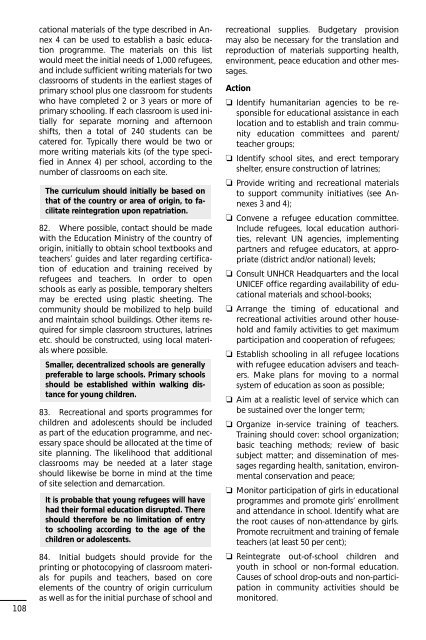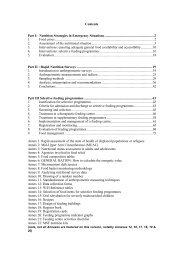UNHCR Handbook for Emergencies - UNHCR eCentre
UNHCR Handbook for Emergencies - UNHCR eCentre
UNHCR Handbook for Emergencies - UNHCR eCentre
You also want an ePaper? Increase the reach of your titles
YUMPU automatically turns print PDFs into web optimized ePapers that Google loves.
108<br />
cational materials of the type described in Annex<br />
4 can be used to establish a basic education<br />
programme. The materials on this list<br />
would meet the initial needs of 1,000 refugees,<br />
and include sufficient writing materials <strong>for</strong> two<br />
classrooms of students in the earliest stages of<br />
primary school plus one classroom <strong>for</strong> students<br />
who have completed 2 or 3 years or more of<br />
primary schooling. If each classroom is used initially<br />
<strong>for</strong> separate morning and afternoon<br />
shifts, then a total of 240 students can be<br />
catered <strong>for</strong>. Typically there would be two or<br />
more writing materials kits (of the type specified<br />
in Annex 4) per school, according to the<br />
number of classrooms on each site.<br />
The curriculum should initially be based on<br />
that of the country or area of origin, to facilitate<br />
reintegration upon repatriation.<br />
82. Where possible, contact should be made<br />
with the Education Ministry of the country of<br />
origin, initially to obtain school textbooks and<br />
teachers’ guides and later regarding certification<br />
of education and training received by<br />
refugees and teachers. In order to open<br />
schools as early as possible, temporary shelters<br />
may be erected using plastic sheeting. The<br />
community should be mobilized to help build<br />
and maintain school buildings. Other items required<br />
<strong>for</strong> simple classroom structures, latrines<br />
etc. should be constructed, using local materials<br />
where possible.<br />
Smaller, decentralized schools are generally<br />
preferable to large schools. Primary schools<br />
should be established within walking distance<br />
<strong>for</strong> young children.<br />
83. Recreational and sports programmes <strong>for</strong><br />
children and adolescents should be included<br />
as part of the education programme, and necessary<br />
space should be allocated at the time of<br />
site planning. The likelihood that additional<br />
classrooms may be needed at a later stage<br />
should likewise be borne in mind at the time<br />
of site selection and demarcation.<br />
It is probable that young refugees will have<br />
had their <strong>for</strong>mal education disrupted. There<br />
should there<strong>for</strong>e be no limitation of entry<br />
to schooling according to the age of the<br />
children or adolescents.<br />
84. Initial budgets should provide <strong>for</strong> the<br />
printing or photocopying of classroom materials<br />
<strong>for</strong> pupils and teachers, based on core<br />
elements of the country of origin curriculum<br />
as well as <strong>for</strong> the initial purchase of school and<br />
recreational supplies. Budgetary provision<br />
may also be necessary <strong>for</strong> the translation and<br />
reproduction of materials supporting health,<br />
environment, peace education and other messages.<br />
Action<br />
❏ Identify humanitarian agencies to be responsible<br />
<strong>for</strong> educational assistance in each<br />
location and to establish and train community<br />
education committees and parent/<br />
teacher groups;<br />
❏ Identify school sites, and erect temporary<br />
shelter, ensure construction of latrines;<br />
❏ Provide writing and recreational materials<br />
to support community initiatives (see Annexes<br />
3 and 4);<br />
❏ Convene a refugee education committee.<br />
Include refugees, local education authorities,<br />
relevant UN agencies, implementing<br />
partners and refugee educators, at appropriate<br />
(district and/or national) levels;<br />
❏ Consult <strong>UNHCR</strong> Headquarters and the local<br />
UNICEF office regarding availability of educational<br />
materials and school-books;<br />
❏ Arrange the timing of educational and<br />
recreational activities around other household<br />
and family activities to get maximum<br />
participation and cooperation of refugees;<br />
❏ Establish schooling in all refugee locations<br />
with refugee education advisers and teachers.<br />
Make plans <strong>for</strong> moving to a normal<br />
system of education as soon as possible;<br />
❏ Aim at a realistic level of service which can<br />
be sustained over the longer term;<br />
❏ Organize in-service training of teachers.<br />
Training should cover: school organization;<br />
basic teaching methods; review of basic<br />
subject matter; and dissemination of messages<br />
regarding health, sanitation, environmental<br />
conservation and peace;<br />
❏ Monitor participation of girls in educational<br />
programmes and promote girls’ enrollment<br />
and attendance in school. Identify what are<br />
the root causes of non-attendance by girls.<br />
Promote recruitment and training of female<br />
teachers (at least 50 per cent);<br />
❏ Reintegrate out-of-school children and<br />
youth in school or non-<strong>for</strong>mal education.<br />
Causes of school drop-outs and non-participation<br />
in community activities should be<br />
monitored.



